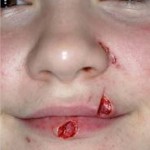One of the most common traumatic facial injuries to deal with in children as a plastic surgeon are dogbites. There are a lot more common than most people think and, fortunately, are usually minor and result in no significant scarring. They often are just ‘nips’ and don’t require any major reconstructive surgery.
But having been at a University for many years before entering private plastic surgery practice, I had the unfortunate opportunity to see more than my share of major dogbite injuries to the face…the vast majority being in children. I reported my pediatric dogbite experience in the March 2013 issue of the Journal of Craniofacial Surgery over a ten year period while covering a major children’s hospital. From 1995 to 2005, I treated over 100 major dogbites the face, scalp and neck in children that required surgical repair in the operating room. The average age of the patients was 6 years old and was fairly evenly split between boys and girls. In most cases the dog was known to the patient or family and was classified as ‘provoked’. The most common dog breeds were Pit Bull, Chow, German Shephard and Doberman Pinscher. Most injuries could be primarily closed but a few did need skin grafts or other reconstructive surgery.
Contrary to popular perception, only one patient developed an infection. Surprisingly, only one patients was left with a permanent facial nerve weakness. In more than three-fourths of the patients, scar revisions were needed and another third needed more than one scar revision.

Like many traumatic injuries dog bites to the face often require repeated plastic surgery procedures to obtain the optimal aesthetic outcome. One should not try and be too clever at the time of initial injury repair with complex closure decisions as the tissue quality often precludes the optimal aesthetic result from the primary repair.
Dr. Barry Eppley
Indianapolis, Indiana


